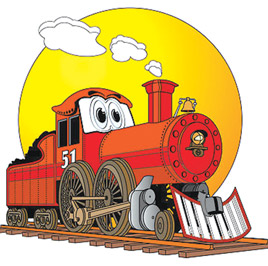The narrow gauge line
For the second time in the history of Sri Lankan Railways, narrow
gauge Railways are back in action from February 4 2012 at Oyamaduwa,
Deyata Kirula exhibition premises, Anuradhapura.
 Originally, narrow gauge railways were used in three sections of Sri
Lanka where sharp curves were available due to the geography of the
region. The main difference of narrow gauge was the width of the track:
for narrow gauge the standard was 2 feet 6 inches while for broad gauge
it was 5 feet 6 inches. Originally, narrow gauge railways were used in three sections of Sri
Lanka where sharp curves were available due to the geography of the
region. The main difference of narrow gauge was the width of the track:
for narrow gauge the standard was 2 feet 6 inches while for broad gauge
it was 5 feet 6 inches.
Originally these type of railways were used way back in 1906
connecting broad gauge from Nanu Oya to Ragala via Nuwara Eliya,
popularly known as Uda-Puswellawa or UPR line.
However, among the narrow gauge lines the longest line was laid along
Kelani valley lasted for a long period for closer to a century and
popular one. This line had two stretches. The main line was from Fort to
Openayake via Avissawella and Ratnapura.
 In addition, there was a branch line from Avissawella to Yatiyantota.
Except, the Openayake line, Avissawella to Yatiyantota and UPR lines
were removed during the Second World War period by the British due to
lack of revenue. The Openayake line also was shortened to Ratnapura
sometime back and in 1974, even terminus of KV line was further
shortened to Avissawella and later to Homagama. In addition, there was a branch line from Avissawella to Yatiyantota.
Except, the Openayake line, Avissawella to Yatiyantota and UPR lines
were removed during the Second World War period by the British due to
lack of revenue. The Openayake line also was shortened to Ratnapura
sometime back and in 1974, even terminus of KV line was further
shortened to Avissawella and later to Homagama.
The main reasons behind the extinction of narrow gauge railways were
due to the lack of speedy operations.
This was due to the sharp curves occurring regularly along the
tracks. In order to overcome this problem during the latter part of the
1990s, Fort to Avissawella stretch was converted to a broad gauge track.
During this transformation, for a short period, both lines were kept
available using one rail in addition to broad gauge track.
The completion of this conversion took place in 1997 and after that
rolling stock of narrow gauge were restricted to a shed only and some of
them were sold as scrap and only few locomotives of steam and diesel and
one steam rail car were kept in the running shed at Dematagoda and did
not even start the engines of these locomotives afterwards.
However, a team of railway technical staff undertook this massive
project to restore two locomotives to be operated in the Deyata Kirula
exhibition nearly 10 months before the exhibition.
-Internet
|


